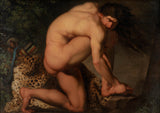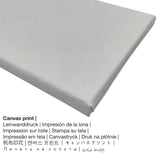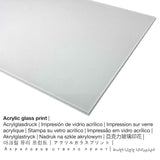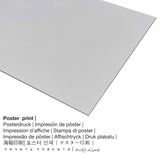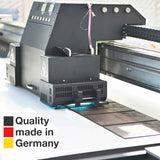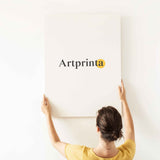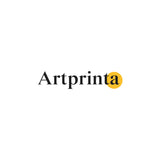Nicolai Abildgaard, 1775 - The Wounded Philoctetes - tirage d'art
TTC Expédition calculée à la caisse.
À propos de ce tableau vieux de plus de 240 ans
Le plus 240 une œuvre d'art vieille d'un an a été créée par Danois peintre Nicolaï Abildgaard in 1775. The piece of art belongs to the Statens Museum for Kunst (Galerie nationale du Danemark) collection d'art, qui est le plus grand musée des beaux-arts du Danemark et est rattachée au ministère danois de la Culture. Avec l'aimable autorisation de Galerie nationale du Danemark (domaine public).:. De plus, l'alignement est paysage d'été and has a ratio of 1.4 : 1, which implies that the length is 40% longer than the width. Nicolai Abildgaard was a painter from Denmark, whose style can mainly be assigned to Romanticism. The Romanticist painter lived for a total of 66 ans, né en 1743 in Copenhagen and died in the year 1809 in Copenhagen.
Matériaux de produits que nos clients peuvent choisir
In the dropdown selection right next to the article you can pick your prefered size and material. The following options are available for individualization:
- Impression sur verre acrylique (avec revêtement en verre véritable): The print on acrylic glass, which is sometimes described as a UV print on plexiglass, makes the original work of art into wonderful wall décor and offers a distinct alternative to dibond and canvas prints. Your favorite artwork is manufactured with modern UV direct printing machines. The special effect of this are sharp and rich colors.
- Impression dibond en aluminium: An Aluminium Dibond print is a material with a true depth effect. The non-reflective surface structure creates a fashionable impression. A direct Aluminium Dibond Print is your ideal introduction to art replicas with aluminum. For our Direct Aluminium Dibond option, we print the favorite artpiece right onto the surface of the white-primed aluminum composite. This direct print on aluminium is one of the most popular entry-level products and is a truly sophisticated way to showcase art, since it puts the viewer’s focus on the image.
- L'impression d'affiche (matériau en toile): The poster print is a UV printed canvas paper with a nice surface finish. Please note, that depending on the absolute size of the poster print we add a white margin of something between 2-6cm around the print motif, which facilitates the framing.
- Impression sur toile: The canvas print is a printed cotton canvas mounted on a wooden frame. Canvas prints are relatively low in weight. That means, it is quite simple to hang your Canvas print without any wall-mounts. Canvas prints are suitable for any type of wall in your house.
Avertissement légal: We try our utmost to depict our products as closely as possible and to exhibit them visually on the respective product detail pages. Still, some colors of the print products and the print result might diverge somehwat from the presentation on your screen. Depending on your settings of your screen and the quality of the surface, not all colors are printed as exactly as the digital version. Because all fine art prints are printed and processed manually, there may as well be slight variations in the motif's size and exact position.
Le produit
| Type de produit: | reproduction d'art |
| Méthode de reproduction: | reproduction au format numérique |
| Technique de fabrication: | Impression directe UV (impression numérique) |
| Origine du produit: | produit en Allemagne |
| Type de stock: | à la demande |
| Utilisation prévue du produit: | design de la maison, art mural |
| Alignement de l'oeuvre: | alignement du paysage |
| Ratio d'aspect: | 1.4: 1 - (longueur: largeur) |
| Implication du rapport hauteur / largeur: | la longueur est 40% plus longue que la largeur |
| Matériaux de produit disponibles: | impression sur toile, impression d'affiche (papier toile), impression métallique (aluminium dibond), impression sur verre acrylique (avec revêtement en verre véritable) |
| Variantes de toile sur châssis de civière (impression sur toile): | 70 x 50 cm - 28 x 20 ", 140 x 100 cm - 55 x 39" |
| Variantes d'impression sur verre acrylique (avec revêtement en verre véritable): | 70 x 50 cm - 28 x 20 ", 140 x 100 cm - 55 x 39" |
| Impression d'affiches (papier canevas): | 70x50cm - 28x20 " |
| Variantes de taille d'impression en aluminium (matériau aluminium dibond): | 70 x 50 cm - 28 x 20 ", 140 x 100 cm - 55 x 39" |
| Encadrement de la copie d'art: | Sans cadre |
Informations sur les œuvres d'art
| Titre de la peinture: | "The Wounded Philoctetes" |
| Catégorisation: | peinture |
| Catégorisation de l'art: | art classique |
| siècle: | 18th siècle |
| Créé dans l'année: | 1775 |
| Âge de l'oeuvre: | autour 240 ans |
| Musée: | Musée Statens pour Kunst (Galerie nationale du Danemark) |
| Emplacement du musée: | Copenhague, Danemark |
| URL Web: | Musée Statens pour Kunst (Galerie nationale du Danemark) |
| Licence d'oeuvre d'art: | domaine public |
| Avec l'aimable autorisation de: | Galerie nationale du Danemark |
Bref aperçu de l'artiste
| Nom : | Nicolaï Abildgaard |
| Sexe de l'artiste: | mâle |
| Nationalité de l'artiste: | Danois |
| Travaux: | peintre |
| Pays d'origine: | Danemark |
| Classement de l'artiste: | vieux maitre |
| Styles d'art: | le romantisme |
| Décédé âgé: | 66 ans |
| Année de naissance: | 1743 |
| Lieu de naissance: | Copenhague |
| Année de décès: | 1809 |
| Décédé à (lieu): | Copenhague |
Ce texte est protégé par le droit d'auteur © | www.artprinta.com (Artprinta)
General information from Statens Museum for Kunst (National Gallery of Denmark) (© Copyright - Statens Museum for Kunst (National Gallery of Denmark) - Musée Statens pour Kunst (Galerie nationale du Danemark))
From 1772 Abildgaard spent five years in Rome thanks to a scholarship granted by the Royal Danish Academy of Fine Arts in Copenhagen. It was while in Rome that he created this depiction of the legendary hero Philoctetes, whose screams of pain caused by a festering snakebite made his comrades-in-arms abandon him on a Greek island during the Trojan war.
Challenging neoclassicism The dominant and deeply rooted movement within figure painting at this time was neoclassicism with its emphasis on self-command and calm. Abildgaard challenges this pattern with his depiction of a body convulsively curved around an axis of pain; a body that feels like it is forcefully restrained within the picture field with its tense musculature and twisted limbs.
Avantgarde, pathos and Weltschmerz The 1770s brought with them an increased emphasis on grand passions among the Northern European ”avant-garde”, and this new outlook also left its mark on Abildgaard’s circles in Rome. The interest in pathos and Weltschmerz is clearly evident in his works from this era.
In this case he used a principal work of classical sculpture as the basis for his rendition of Philoctetes’ tormented state: The Torso Belvedere in the Vatican museum served as the model for the plastic and mannered rendition of the hero’s upper body. With this move, Abildgaard’s stylistic innovation was imbued with features of a work canonised by neoclassicism – without, however, reducing the tensions in the painting.

